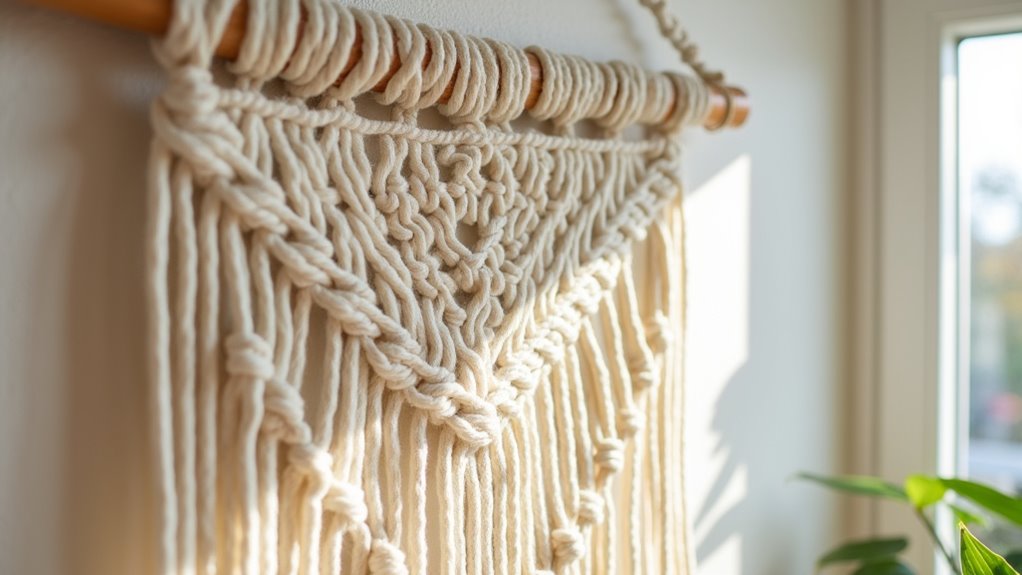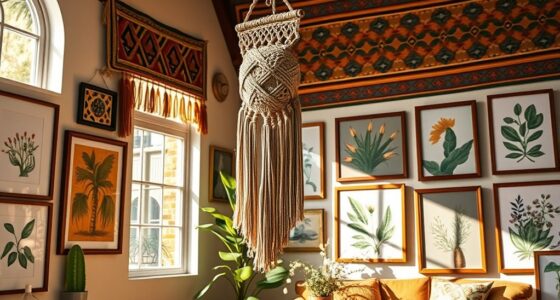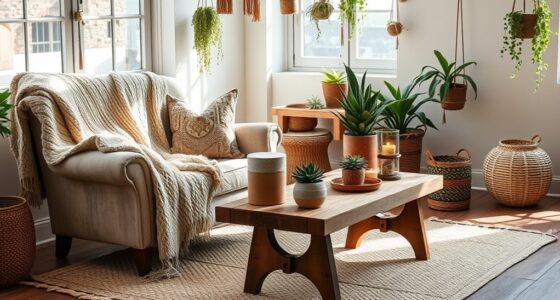To create your own boho-style wall hangings, gather natural fibers like cotton or jute, along with tools such as scissors and a wooden dowel. Learn basic knots like the square knot and half hitch to design layered textures. Incorporate decorative beads and natural elements for a personalized touch. Mount your piece with simple hooks or nails, and keep experimenting with different techniques and updates to keep your decor fresh and stylish. Keep exploring to unseal more creative ideas.
Key Takeaways
- Gather high-quality cords, natural materials, and decorative elements; prepare a clean, well-lit workspace.
- Learn and practice basic knots like square, half hitch, and lark’s head to create various patterns.
- Incorporate beads, feathers, and tassels to add boho charm and texture to your wall hangings.
- Use natural fibers and organic accents such as shells or dried flowers for a rustic, earthy look.
- Mount your finished piece securely with a dowel or branch and maintain it regularly for lasting beauty.
Gathering Your Materials and Tools
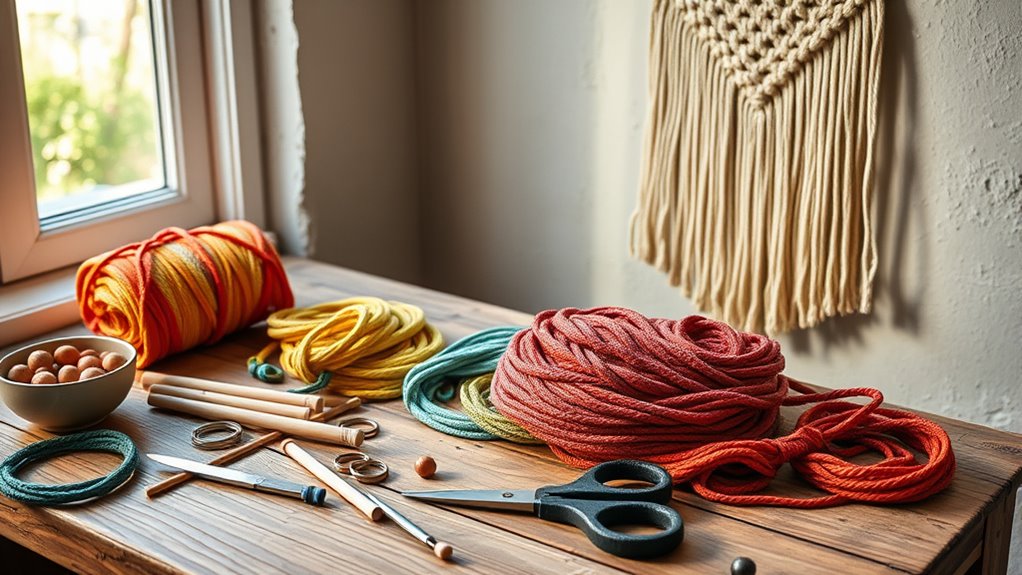
Before you start your macramé project, gather all necessary materials and tools to guarantee a smooth crafting experience. Choose high-quality cotton cord or jute rope, typically 3mm to 5mm thick, as your primary material for wall hangings. Collect essential tools like scissors, a measuring tape, and a wooden dowel or branch for hanging your piece. You might also want a comb or brush for fringing details. Select a workspace with good lighting and a flat surface to easily measure and cut your cords to the right lengths. Consider preparing decorative elements like beads, feathers, or tassels if you want to personalize your design. Confirm everything is clean and organized beforehand, so your crafting process flows seamlessly and you enjoy creating your boho-inspired wall hanging. Additionally, ensure your workspace is free from electronic interference to prevent any issues if you plan to incorporate electronic components or lighting elements into your design. Remember to keep your space inspired by a cozy farmhouse bedroom ambiance, which will help you stay motivated and creative during your crafting session. Incorporating quality materials will also enhance the durability and overall appearance of your finished piece. Being mindful of spiritual guidance can inspire your creative choices and add a meaningful touch to your decor. It’s also helpful to familiarize yourself with air purifier maintenance dos and don’ts to keep your crafting environment clean and fresh.
Basic Knots for Macramé: A Step-by-Step Guide
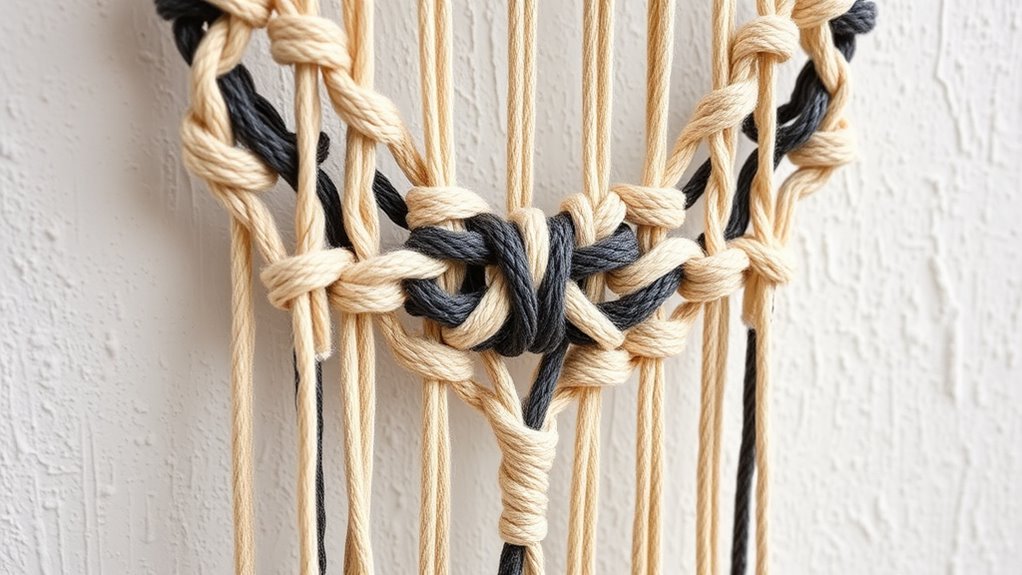
Understanding basic knot techniques is essential for creating beautiful macramé projects. You’ll learn how to tie patterns like the square knot, half hitch, and lark’s head knot, which form the foundation of most designs. Practicing these will help you make tight, secure knots for your wall hangings and decorations. Incorporating knowledge of Gold IRA fees can help you understand the importance of transparency and cost-effectiveness in your investments, which parallels choosing quality materials and techniques in craft projects. Additionally, mastering these knots can help you incorporate eco-friendly and sustainable materials into your designs, supporting sustainable backyard practices. Developing a growth mindset can also assist you in refining your skills and tackling more complex designs as you progress. Focusing on durable, non-toxic materials ensures that your finished pieces are both safe and long-lasting, enhancing your confidence in your craft.
Basic Knot Techniques
Mastering basic knot techniques is essential for creating beautiful and sturdy macramé wall hangings. The square knot and spiral knot are foundational, forming the basis of many patterns and textures. To make a basic knot, fold your cord to create a loop, then pass the working end around and through the loop, tightening to secure. Consistent tension and even spacing help your piece look professional and balanced. Experimenting with different materials like cotton, jute, or nylon will influence the texture and overall appearance of your wall hanging. Practice each knot individually until you’re comfortable, because this builds confidence and improves your technique. Additionally, understanding knot tension is crucial for achieving a uniform and polished look in your projects. When you develop a good sense of tension, your knots will appear more uniform and neat, enhancing the overall aesthetic. Developing an eye for material texture can further elevate your designs and add unique character to your wall hangings. Recognizing the importance of consistent tension helps ensure your project looks cohesive and professional. Paying attention to cybersecurity best practices, such as safeguarding your designs and personal information online, can help protect your creative work from potential threats. Once you master these basics, you’ll be ready to explore more complex designs and patterns with ease.
Tying Patterns Overview
Once you’ve practiced the basic knots like the square knot, half hitch, and lark’s head, you can start exploring how to combine them into different patterns. These knots form the foundation for various designs, allowing you to create unique wall hangings. The lark’s head knot is usually your starting point, attaching cords to a dowel, while the square knot offers stability and symmetry. Mixing and matching these knots with consistent tension yields balanced, professional-looking results. Below is a simple overview:
| Knot Type | Description | Common Use |
|---|---|---|
| Lark’s Head | Attaches cords to a dowel or ring | Starting a wall hanging |
| Square Knot | Ties two half hitches in opposite directions | Creating patterns, sections |
| Half Hitch | Wraps around a cord or dowel | Forming borders and designs |
Tips for Tight Knots
Achieving tight knots is essential for a sturdy and polished macramé wall hanging, and controlling tension is key to that goal. To do this, hold the cord firmly near the knot and pull the working end slowly and steadily to eliminate slack. Consistent tension while tying knots like Square or Half Hitch ensures a uniform, professional look. Practice basic knots—lark’s head, square, double half hitch—with controlled tension to improve knot tightness over time. Securing cords with a clamp or tape while working helps maintain tension and prevents slipping. Remember, patience and deliberate movements make a significant difference in knot quality. Proper tension control is also influenced by the type of cord material, as some fibers hold tension better than others.
Designing Your Unique Wall Hanging
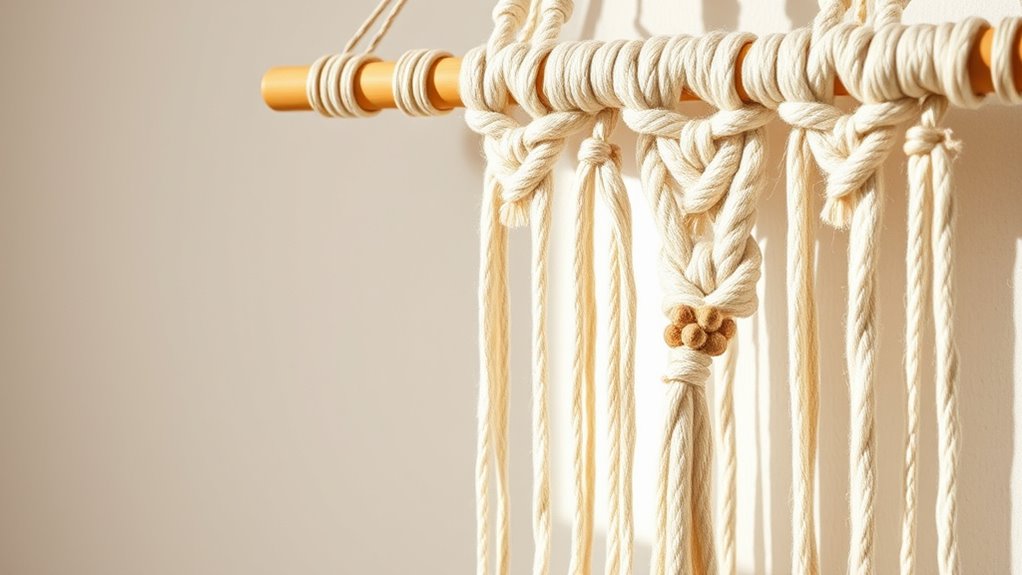
To create a truly unique wall hanging, start by selecting a variety of cords or ropes in different textures, colors, and thicknesses. This mix adds visual interest and allows you to customize your design. Next, plan your layout by sketching your pattern or using a simple grid to map out knot placements and lengths. Incorporate special elements like beads, feathers, or charms to add personal touches and enhance the overall look. Experiment with different knot techniques such as square knots, half-hitches, and spiral knots to create varied textures and patterns. Be sure to measure and mark your cords carefully to maintain symmetry and balance, ensuring your wall hanging looks cohesive and polished from every angle. Additionally, understanding family photoshoot fails can inspire playful and humorous touches to your decor.
Techniques for Adding Textures and Layers
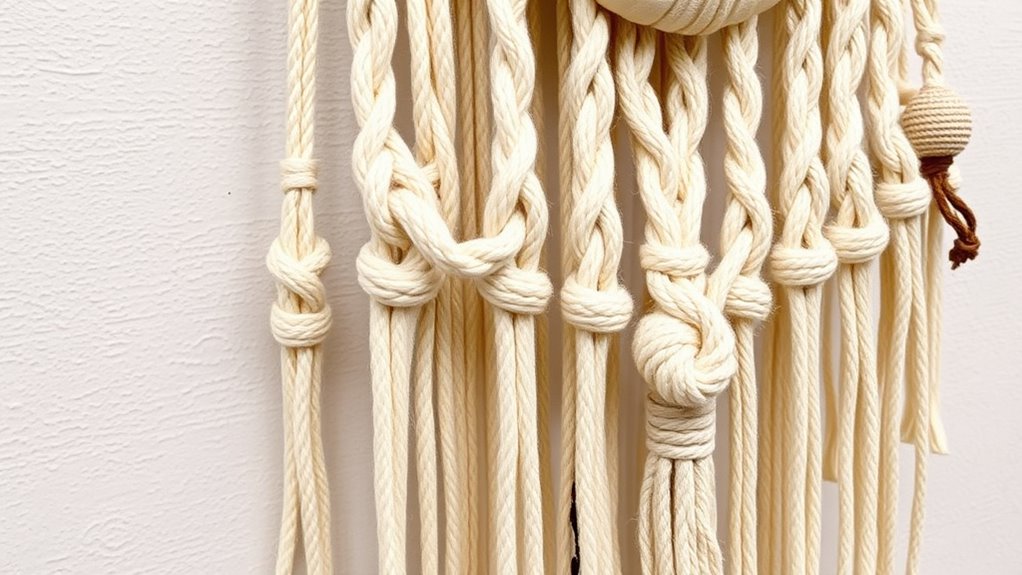
Adding textures and layers brings your wall hanging to life by creating visual interest and depth. You can achieve this by mastering different knotting techniques like square knots, half hitch, and double half hitch, which add dimension and structure. Using a variety of cords such as jute, cotton, and hemp introduces tactile variation and rich visual contrast. Combining different hanging lengths and knot styles within one piece creates a layered, three-dimensional effect that feels dynamic. You can also incorporate embellishments like beads, feathers, or tassels between layers to add both texture and movement. Experiment with tight and loose knots to produce contrasting textures, making your piece more complex and engaging. Incorporating archives of trending designs can inspire new ideas and help you stay updated on popular styles. These techniques enable you to craft a truly unique and textured boho wall hanging, especially when you explore innovative knotting methods that push creative boundaries.
Incorporating Natural Elements and Beads
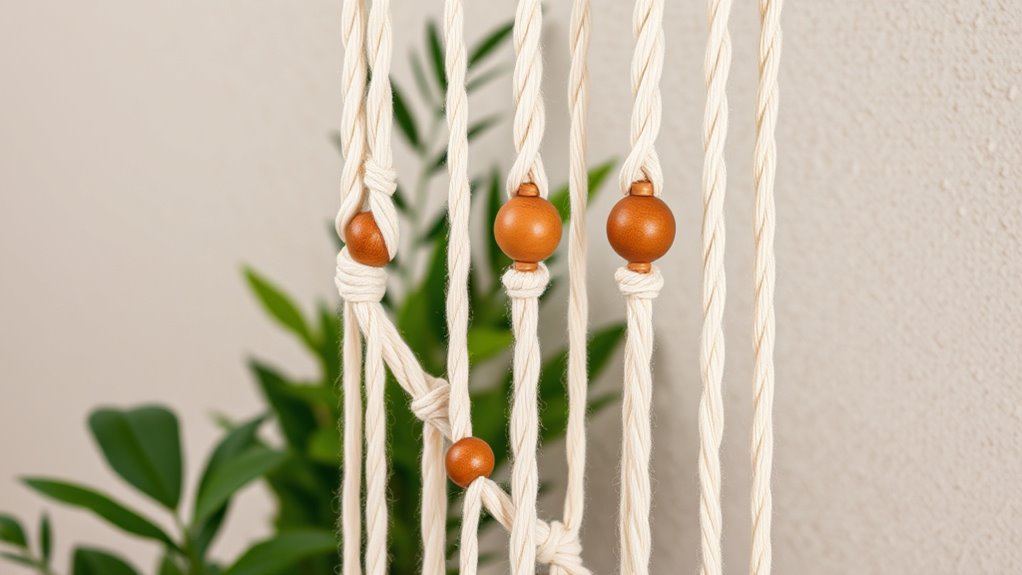
You can enhance your wall hangings by choosing natural materials like shells, stones, and wooden beads to add an earthy touch. Thread beads made from wood, bone, or semi-precious stones into your cords to create texture and visual interest. Incorporating organic shapes and textures helps you craft a cohesive, nature-inspired piece that reflects your personal style.
Selecting Organic Materials
Choosing natural materials like jute, cotton, or hemp cords instantly enhances the earthy appeal of your macramé wall hanging while keeping it eco-friendly. These fibers add texture and authenticity, aligning with a boho aesthetic. When selecting beads, opt for organic options such as wood, bone, shell, or semi-precious stones, which bring tactile interest and a grounded vibe. To maintain a rustic look, choose beads with natural finishes or untreated surfaces. Incorporate organic elements like dried flowers, feathers, or small branches to deepen the natural feel of your piece. Consider sustainability by sourcing biodegradable or sustainably harvested materials. Recognizing the historical significance of natural seeds and materials can inspire more meaningful and authentic decor choices.
Adding Beaded Accents
Ever wondered how to elevate your macramé wall hanging with natural accents? Incorporating elements like shells, stones, or feathers adds organic texture and enhances the boho vibe. You can sew beads directly onto the cords or string them onto loops for decorative dimension. Mixing different bead types—wooden, glass, or metal—creates visual interest and complements your color scheme. Pairing beaded accents with natural materials such as driftwood or rattan results in cohesive, earthy designs perfect for boho decor. Experimenting with various beading patterns like zigzags or clusters allows you to craft personalized, unique wall hangings. Incorporating visual balance ensures your design remains harmonious and aesthetically pleasing. These small touches bring depth and character, transforming a simple piece into a captivating statement for your space.
Mounting and Displaying Your Creations

To guarantee your macramé or wall hanging stays securely in place and looks its best, selecting the right mounting method is essential. Use sturdy nails, hooks, or adhesive strips suited for your wall type to ensure stability. Installing a wooden dowel or tension rod at the top can make hanging easier and give your piece a polished appearance. Measure and mark the wall beforehand to keep your creation centered and at the right height. For heavier hangings, clear wall anchors prevent damage and enhance security. Don’t be afraid to experiment with different display options—hanging from a single point or multiple hooks—to best showcase your boho decor. Incorporating self watering plant pots or other vertical storage solutions can also help keep your space organized and make hanging displays more prominent. Being aware of retail store hours can help you plan visits for any additional supplies you might need. Additionally, understanding mounting techniques can help avoid damage and ensure your art stays beautifully displayed over time.
Tips for Maintaining and Updating Your Decor
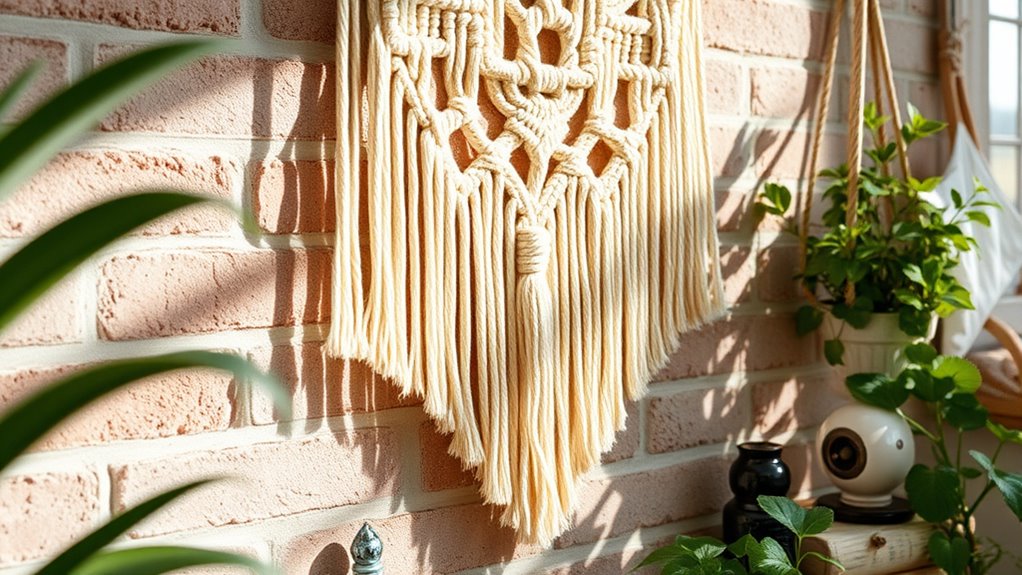
Keeping your wall hangings looking their best requires regular maintenance and thoughtful updates. Dust and gently vacuum your pieces often to prevent dust buildup without damaging delicate fibers. Rotate or reposition your macramé periodically to refresh their look and prevent uneven fading from sunlight. For stains, use fabric-safe cleaners or spot treatments, avoiding harsh chemicals that could weaken the fibers. To give your decor a quick update, add new elements like beads or color accents to your existing wall hangings. Also, make certain your pieces stay away from direct heat sources and high humidity, which can damage the fibers over time. Incorporating personal development techniques like mindfulness into your routine can help you stay attentive to your decor’s upkeep. Regular care and subtle updates will keep your boho decor vibrant and beautiful for years to come. Additionally, understanding the emotional significance behind your decor can help you select meaningful updates that resonate with your personal style and relationships.
Frequently Asked Questions
What Are the Best Types of Yarn or Cords for Macramé?
When choosing yarn or cords for your project, you want options that are strong, flexible, and easy to work with. Cotton is a popular choice because it’s durable and soft, perfect for intricate knots. Jute or hemp cords add a rustic vibe and are sturdy for larger pieces. Polyester cords are also great—they’re smooth and hold knots well. Pick based on your style and the look you want to achieve.
How Long Does It Typically Take to Complete a Wall Hanging?
You’ll usually spend anywhere from a few hours to a full day completing a wall hanging, depending on its size and complexity. If you’re new to macramé, expect to spend extra time learning knots and perfecting your design. Larger, more intricate pieces take longer, while simple, small hangings can be finished quickly. Break it into sessions if needed, and enjoy the process as you create your boho decor.
Can I Use Recycled or Eco-Friendly Materials for My Projects?
Think of your project as a garden, where eco-friendly materials are the seeds of sustainability. Yes, you can absolutely use recycled or eco-friendly materials for your wall hangings. These materials not only reduce waste but also add unique textures and stories to your creations. By choosing sustainable options, you’re nurturing a greener world while crafting your boho decor. It’s a rewarding way to beautify your space and protect the planet.
What Are Common Mistakes to Avoid in Macramé Knotting?
When learning macramé knotting, you should avoid common mistakes like pulling too tightly, which can distort your design, or not maintaining consistent tension, leading to uneven patterns. Be careful with your knot placement to prevent gaps or overlaps. Rushing through the process can cause mistakes, so take your time. Always double-check your work and practice basic knots until you feel confident, ensuring a neat, professional-looking finished piece.
How Can I Customize Designs for Different Room Styles?
Your creativity transforms simple knots into expressions of style. To customize designs for different room styles, consider the room’s vibe—modern, rustic, or boho—and select colors, textures, and patterns that match. You can incorporate metallic accents for contemporary spaces or natural fibers for a cozy, rustic feel. By blending your personal taste with these elements, you craft wall hangings that truly resonate with each unique room’s personality.
Conclusion
Now that you’ve learned the basics, your DIY macramé projects can turn your space into a cozy, boho haven. Think of your wall hangings as a canvas waiting to be painted with textures, beads, and natural elements that reflect your personality. With patience and creativity, you’ll craft pieces that feel as unique as you are—like a breath of fresh inspiration for your decor. So, immerse yourself and let your imagination hang free!
